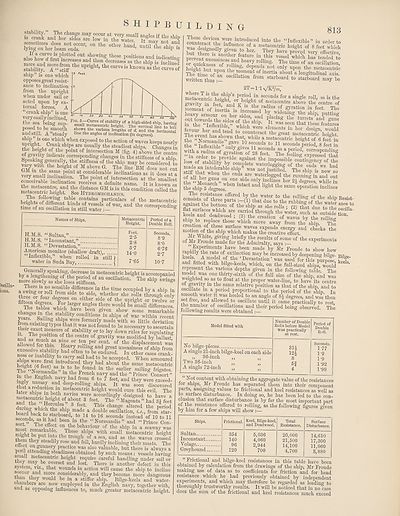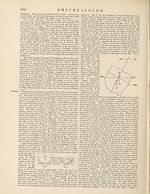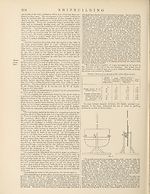Encyclopaedia Britannica > Volume 21, ROT-Siam
(823) Page 813
Download files
Complete book:
Individual page:
Thumbnail gallery: Grid view | List view

)scilla-
ions.
SHIP BUILD I
stability.” The change may occur at very small amrlp* if c.i •
is crank and her sides are low in the water TtZv l Sln?
-the
Zmty. T° S the Uprigl“- tlM iS -
ship ” is one which
opposes great resist¬
ance to inclination
from the upright
when under sail or
acted upon by ex¬
ternal forces. A
“crank ship” is one
very easily inclined,
the sea being sup¬
posed to be smooth
and still. A “steady
N Gr
813
Fllf;rCTe °{ of a high-sided ship, having
small metacentne height. The vertical line to left
the various lengths of d, and the horizontal
./ lnc ^he angles of inclination (in degrees).
shi]i ” is one which when exposed to the action of waves keeps nearly
upnght. Crank ships are usually the steadiest ships. Changes ^
the height of the point of intersection M (fig. 4) above the centre
of gravity indicate corresponding changes in the stiffness of a ship
Speaking generally the stiffness of the ship may be considered to
GMrinW‘lthe he«h.t »f “ G. The line BM does noTcS
GM m the same point at considerable inclinations as it does at a
““pinar„„ SvTa*
mete” ntr'™height. See AMcl!"8 C0Ildlti™ 11,6
t •t.a tab.le contains particulars of the metacentric
eights of different kinds of vessels of war, and the corresponding
time of an oscillation in still water unesponumg
Names of Ships.
H.M.S. “ Sultan,”
H.M.S. “Inconstant,”
H.M.S. “Devastation,” ^
American monitor (shallow draft)’!
“Inflexible,” when rolled in ’stiii
water in Suda Bay,
Metacentric
Height.
Feet.
2-5
2-8
37
14-0
7-65
Seconds.
8'9
8-0
676
2-7
107
Generally speaking, decrease in metacentric height is accomnanied
1“Sl1hem"(? °f ‘he period of an oscillation.0 The shTp ISs
more slowly as she loses stiffness. 1 t.wings
1 here is no sensible difference in the time occupied by a shin in
Hrrogr0te0Udfr0mSide t0vSide> Whether she 10lls though only
three or four degrees on either side of the upright or twelve or
The tebles8 which bger there would ^ small differences.
changes hr the ^ ^ ^.vent show remarkable
changes m the stability conditions m ships of war within recent
years. Sailing ships were formerly made with so little deviation
from existing types that it was not found to be necessary to asler ain
t “noSnofl StabiJity f t0 ky d0Wn rules f-regXting
and as Xb °\f ^ °f graVlty Was modided by ballast^
allowed fo? this He6 °r ir Per C<int- of the displacement was
excessive stelfilHv ? l ^ H and great Ulleasiness of ship from
ness o - tea fi rivi d ^ 1° ^/ndured. In other cases crank¬
ness or inability to carry sail had to be accepted. When armoured
he StWSefee1tfa1snir?UCBdftlieyrihad \bout the same ^e™trfc
TIi5reet) as !s to be found m the earlier sailing frigates
” the P,Xl, m,th? fFre"ch nary a,ld the “ r™cegComort "
in the English navy had from 6 to 7 feet, and they were exceed-
th!tyaieduactyionabd de?'r0lfI?SnSbir U WaS S00n discovered
later shins te WB metacentnc heigbt would cure this evil. The
later ships m both navies were accordingly designed to have a
metacentric height of about 3 feet. The “Magenta” had 34 feet
and the “Hercules” 3 feet. This changf altered the ptriod
boaJKkt11 t!10vShlp1 made a double oscillation, i.e., fromPstar-
seeonds S !;,0,starboard». to 14 to 16 seconds instead of 10 to 11
sort ”d The beeWve hiormandie ” and “Prince Con-
most remarksBl fc bebaviour of tbe ship ih a seaway was
niSlri te W f pi, Ti1CSe iShip/ Wlth sma11 metacentric height
themrimvstcfn the trougb ofa sea, and as the waves crossed
. ,r ^ t ley steadily rose and fell, hardly inclining their masts The
■noriff??goooery practice was also valuable, but there is always a
peril attending steadiness obtained by such means : vessels having
tw “ettCentrlC belgbt squire careful handling under sail or
y may be overset and lost. There is another defect in this
system, viz., that wounds in action will cause the ship to incline
sooner and more considerably, and they become more dangerous
than they would be in a stiffer ship. Bilge-keels and water-
efiambers are. now employed in the English navy, together with,
and as opposing influences to, much greater metacentric height.
countertrtheTnf!niutr°cblCed into tbe “Inflexible” in order to
wa« rill t i mfluence of a metacentric height of 8 feet which
was designedly given to her. They have proved very effective
but there is another feature in this vessel whiS has tended to
or qScknesT'orronte h"?'7 The time °f an o^illarion,
height but unon Hip cepend? n°I onIy npon the metacentric
Th? t the moment of inertia about a longitudinal axis
Written Zl:- OS“1IatIOn fr°m s'ari»rd starUTlrS
2T = 11V-E5K'
StaenWc tSVrtd8 Z 8 S?gle't11' “ is tlle
gravity in feet ^ri V ' 8^ f r etac®ntrG above the centre of
moment of teprifn d • 13 the/adlus of gyration in feet. The
oTtLaaXL°sid£Sld 4"1 t-ete ^0!
1™,° h8rnaSibtle'd t"'U0l‘ ™
The event has shown tb°flrUviraCt the great metacentric height.
Hip “at i• ° tbat’ whlle a metacentric height of 6 feet in
the “ fXtel » gfVe .10 SeCOnds t0 11 sec°nds feriod, 8 feet in
with a radius of gyrltif^M^Vtcet^^^ffp011, COrresp°ndjng
losTo^sTb-r/T^6 agaiust the impossible cofitSle^cyo/the
made an nSSbl7 waterlogging of the eS^we had
stiff that whin hlri was n°t justified. The ship is now so
in that when the ends are waterlogged the running in and nnt-
s s--
ship to replace those which move away from the^hip Thf
creation of these surface waves expends energy and checks the
“l10 wn .the Sblp wbicb makes the creative effort
nf 1? vZ glvrng hriofly the results of some of the experiments
of Mr Fronde made for the Admiralty, says 1
Experiments have been made by Mr Fronde to show how
rapidly the rate of extinction may be increased by deepening bifoe- Bite
kec:ls- A mode! of the ‘ Devastation > was used for this purnose ? f'
and fitted with bilge-keels, which, on the full-sized ships, would keelS'
epiesent the various depths given in the following table The
model was one thirty-sixth of the full size of the ship, and was
weighted so as to float at the proper water-line, to havePits centre
°t gravity in the same relative position as that of the ship, and to
oscillate m a period proportional to the period of the ship. In
Zl0Zh Wat?r p was beeled 1° an angle of 8J degrees, and was then
set free, and allowed to oscillate until it came practically to rest,
the number of oscillations and their period being observed. The
following results were obtained :—
Model fitted with
Ho bilge-pieces
A single 21-inch bilge-keei on each side
„ 36-inch ,,
Two 36-inch ,, j;
A single 72-inch ,, ”
Number of Double
Rolls before Model
was practically
at rest.
Period of
Double
Roll.
31!
12!
8
5f
4
Seconds.
1-77
1-9
1-9
1-92
1-99
Hot content with obtaining the aggregate value of the resistances
for ships, Mr Froude has separated them into their component
parts, assigning values to frictional and keel resistances as well as
to surface disturbance. In doing so, he has been led to the con¬
clusion that surface disturbance is by far the most important part
of the resistance offered to rolling, as the following figures given
by him for a few ships will show ;—
Ships.
Sultan
Inconstant.
Yolage
Greyhound.
Frictional
354
140
96
120
Keel, Bilge-keel,
and Deadwood
5,036
4,060
2,944
700
Total
Resistance.
20,000
21,500
14,100
4,700
Surface
Disturbance.
14,610
17,300
11,060
3,880
Frictional and bilge-keel resistances in this table have been
obtained by calculation from the drawings of the ship, Mr Froude
making use of data as to coefficients for friction and for head
resistance which he. had previously obtained by independent
experiments, and which may therefore be regarded as leading to
thoroughly trustworthy results. It will be noticed that in no case
does the sum of the frictional and keel resistances much exceed
ions.
SHIP BUILD I
stability.” The change may occur at very small amrlp* if c.i •
is crank and her sides are low in the water TtZv l Sln?
-the
Zmty. T° S the Uprigl“- tlM iS -
ship ” is one which
opposes great resist¬
ance to inclination
from the upright
when under sail or
acted upon by ex¬
ternal forces. A
“crank ship” is one
very easily inclined,
the sea being sup¬
posed to be smooth
and still. A “steady
N Gr
813
Fllf;rCTe °{ of a high-sided ship, having
small metacentne height. The vertical line to left
the various lengths of d, and the horizontal
./ lnc ^he angles of inclination (in degrees).
shi]i ” is one which when exposed to the action of waves keeps nearly
upnght. Crank ships are usually the steadiest ships. Changes ^
the height of the point of intersection M (fig. 4) above the centre
of gravity indicate corresponding changes in the stiffness of a ship
Speaking generally the stiffness of the ship may be considered to
GMrinW‘lthe he«h.t »f “ G. The line BM does noTcS
GM m the same point at considerable inclinations as it does at a
““pinar„„ SvTa*
mete” ntr'™height. See AMcl!"8 C0Ildlti™ 11,6
t •t.a tab.le contains particulars of the metacentric
eights of different kinds of vessels of war, and the corresponding
time of an oscillation in still water unesponumg
Names of Ships.
H.M.S. “ Sultan,”
H.M.S. “Inconstant,”
H.M.S. “Devastation,” ^
American monitor (shallow draft)’!
“Inflexible,” when rolled in ’stiii
water in Suda Bay,
Metacentric
Height.
Feet.
2-5
2-8
37
14-0
7-65
Seconds.
8'9
8-0
676
2-7
107
Generally speaking, decrease in metacentric height is accomnanied
1“Sl1hem"(? °f ‘he period of an oscillation.0 The shTp ISs
more slowly as she loses stiffness. 1 t.wings
1 here is no sensible difference in the time occupied by a shin in
Hrrogr0te0Udfr0mSide t0vSide> Whether she 10lls though only
three or four degrees on either side of the upright or twelve or
The tebles8 which bger there would ^ small differences.
changes hr the ^ ^ ^.vent show remarkable
changes m the stability conditions m ships of war within recent
years. Sailing ships were formerly made with so little deviation
from existing types that it was not found to be necessary to asler ain
t “noSnofl StabiJity f t0 ky d0Wn rules f-regXting
and as Xb °\f ^ °f graVlty Was modided by ballast^
allowed fo? this He6 °r ir Per C<int- of the displacement was
excessive stelfilHv ? l ^ H and great Ulleasiness of ship from
ness o - tea fi rivi d ^ 1° ^/ndured. In other cases crank¬
ness or inability to carry sail had to be accepted. When armoured
he StWSefee1tfa1snir?UCBdftlieyrihad \bout the same ^e™trfc
TIi5reet) as !s to be found m the earlier sailing frigates
” the P,Xl, m,th? fFre"ch nary a,ld the “ r™cegComort "
in the English navy had from 6 to 7 feet, and they were exceed-
th!tyaieduactyionabd de?'r0lfI?SnSbir U WaS S00n discovered
later shins te WB metacentnc heigbt would cure this evil. The
later ships m both navies were accordingly designed to have a
metacentric height of about 3 feet. The “Magenta” had 34 feet
and the “Hercules” 3 feet. This changf altered the ptriod
boaJKkt11 t!10vShlp1 made a double oscillation, i.e., fromPstar-
seeonds S !;,0,starboard». to 14 to 16 seconds instead of 10 to 11
sort ”d The beeWve hiormandie ” and “Prince Con-
most remarksBl fc bebaviour of tbe ship ih a seaway was
niSlri te W f pi, Ti1CSe iShip/ Wlth sma11 metacentric height
themrimvstcfn the trougb ofa sea, and as the waves crossed
. ,r ^ t ley steadily rose and fell, hardly inclining their masts The
■noriff??goooery practice was also valuable, but there is always a
peril attending steadiness obtained by such means : vessels having
tw “ettCentrlC belgbt squire careful handling under sail or
y may be overset and lost. There is another defect in this
system, viz., that wounds in action will cause the ship to incline
sooner and more considerably, and they become more dangerous
than they would be in a stiffer ship. Bilge-keels and water-
efiambers are. now employed in the English navy, together with,
and as opposing influences to, much greater metacentric height.
countertrtheTnf!niutr°cblCed into tbe “Inflexible” in order to
wa« rill t i mfluence of a metacentric height of 8 feet which
was designedly given to her. They have proved very effective
but there is another feature in this vessel whiS has tended to
or qScknesT'orronte h"?'7 The time °f an o^illarion,
height but unon Hip cepend? n°I onIy npon the metacentric
Th? t the moment of inertia about a longitudinal axis
Written Zl:- OS“1IatIOn fr°m s'ari»rd starUTlrS
2T = 11V-E5K'
StaenWc tSVrtd8 Z 8 S?gle't11' “ is tlle
gravity in feet ^ri V ' 8^ f r etac®ntrG above the centre of
moment of teprifn d • 13 the/adlus of gyration in feet. The
oTtLaaXL°sid£Sld 4"1 t-ete ^0!
1™,° h8rnaSibtle'd t"'U0l‘ ™
The event has shown tb°flrUviraCt the great metacentric height.
Hip “at i• ° tbat’ whlle a metacentric height of 6 feet in
the “ fXtel » gfVe .10 SeCOnds t0 11 sec°nds feriod, 8 feet in
with a radius of gyrltif^M^Vtcet^^^ffp011, COrresp°ndjng
losTo^sTb-r/T^6 agaiust the impossible cofitSle^cyo/the
made an nSSbl7 waterlogging of the eS^we had
stiff that whin hlri was n°t justified. The ship is now so
in that when the ends are waterlogged the running in and nnt-
s s--
ship to replace those which move away from the^hip Thf
creation of these surface waves expends energy and checks the
“l10 wn .the Sblp wbicb makes the creative effort
nf 1? vZ glvrng hriofly the results of some of the experiments
of Mr Fronde made for the Admiralty, says 1
Experiments have been made by Mr Fronde to show how
rapidly the rate of extinction may be increased by deepening bifoe- Bite
kec:ls- A mode! of the ‘ Devastation > was used for this purnose ? f'
and fitted with bilge-keels, which, on the full-sized ships, would keelS'
epiesent the various depths given in the following table The
model was one thirty-sixth of the full size of the ship, and was
weighted so as to float at the proper water-line, to havePits centre
°t gravity in the same relative position as that of the ship, and to
oscillate m a period proportional to the period of the ship. In
Zl0Zh Wat?r p was beeled 1° an angle of 8J degrees, and was then
set free, and allowed to oscillate until it came practically to rest,
the number of oscillations and their period being observed. The
following results were obtained :—
Model fitted with
Ho bilge-pieces
A single 21-inch bilge-keei on each side
„ 36-inch ,,
Two 36-inch ,, j;
A single 72-inch ,, ”
Number of Double
Rolls before Model
was practically
at rest.
Period of
Double
Roll.
31!
12!
8
5f
4
Seconds.
1-77
1-9
1-9
1-92
1-99
Hot content with obtaining the aggregate value of the resistances
for ships, Mr Froude has separated them into their component
parts, assigning values to frictional and keel resistances as well as
to surface disturbance. In doing so, he has been led to the con¬
clusion that surface disturbance is by far the most important part
of the resistance offered to rolling, as the following figures given
by him for a few ships will show ;—
Ships.
Sultan
Inconstant.
Yolage
Greyhound.
Frictional
354
140
96
120
Keel, Bilge-keel,
and Deadwood
5,036
4,060
2,944
700
Total
Resistance.
20,000
21,500
14,100
4,700
Surface
Disturbance.
14,610
17,300
11,060
3,880
Frictional and bilge-keel resistances in this table have been
obtained by calculation from the drawings of the ship, Mr Froude
making use of data as to coefficients for friction and for head
resistance which he. had previously obtained by independent
experiments, and which may therefore be regarded as leading to
thoroughly trustworthy results. It will be noticed that in no case
does the sum of the frictional and keel resistances much exceed
Set display mode to:
![]() Universal Viewer |
Universal Viewer | ![]() Mirador |
Large image | Transcription
Mirador |
Large image | Transcription
Images and transcriptions on this page, including medium image downloads, may be used under the Creative Commons Attribution 4.0 International Licence unless otherwise stated. ![]()
| Encyclopaedia Britannica > Encyclopaedia Britannica > Volume 21, ROT-Siam > (823) Page 813 |
|---|
| Permanent URL | https://digital.nls.uk/193637978 |
|---|
| Attribution and copyright: |
|
|---|---|
| Shelfmark | EB.17 |
|---|---|
| Description | Ten editions of 'Encyclopaedia Britannica', issued from 1768-1903, in 231 volumes. Originally issued in 100 weekly parts (3 volumes) between 1768 and 1771 by publishers: Colin Macfarquhar and Andrew Bell (Edinburgh); editor: William Smellie: engraver: Andrew Bell. Expanded editions in the 19th century featured more volumes and contributions from leading experts in their fields. Managed and published in Edinburgh up to the 9th edition (25 volumes, from 1875-1889); the 10th edition (1902-1903) re-issued the 9th edition, with 11 supplementary volumes. |
|---|---|
| Additional NLS resources: |
|

